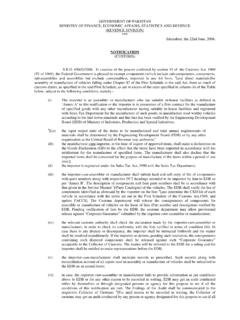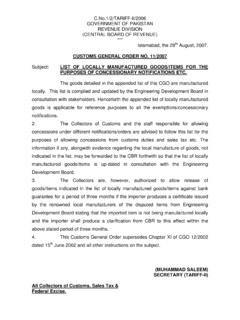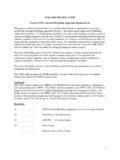Transcription of National Standards and Specification For Trailers / Semi ...
1 National Standards and Specification For Trailers / Semi- Trailers General requirements 1. SCOPE. This standard specifies the requirements for semi- Trailers and full- Trailers meant for transportation of freight containers and general cargo capable of operating at speeds above 30 km/h. This standard does not cover the requirements of special purpose transport tractor Trailers constructed for the transportation of goods of abnormal weight and dimensions, or agricultural Trailers . Trailers for carrying petroleum products and other hazardous products are covered in a separate standard. 2. DEFINITIONS. Semi- trailer trailer used in connection with truck tractor Full- trailer Truck trailer constructed so that all its own weight and that of its load rests upon its own wheels Tractor or Prime Mover Truck portion of articulated vehicle (or combination or train).
2 Superstructure Any structure built above the truck or trailer bed. It can be container for storing goods or a crane mounted on the truck, etc. Undercarriage Means all the components in a trailer or semi- trailer under the frame. This includes axles, suspension, brakes, electrical, landing legs, kingpin, rims, tires and turntable in the full- trailer . Kingpin Front axle pin allowing wheels to steer vehicle. Kingpin is used in combination with 5th wheel. trailer Axle Non-driven axle. It is a beam running crosswise to and supporting chassis. Page 1 of 12. Tandem Axle When two axles are combined by means of balancer such that the axles work in tandem. Suspension Attaching parts including springs for securing axle or axles to chassis frame and providing shock absorption to the vehicle. trailer suspension may be mechanical leaf spring or air suspension.
3 Twist Locks Device to lock the container with the trailer or semi- trailer frame. Turntable Steering arrangement for full- Trailers . Drawbar It is the front part of full- trailer which connects the full- trailer to the towing vehicle. Tow-bar Bar or V-shaped device attached to the chassis of a trailer dolly or front axle. Low-bed trailer and Drop-bed trailer A low-bed trailer has a bed height lower than the flat bed trailer . To achieve the low height a hump has to be made to accommodate the prime mover. A drop-bed trailer is lower than the low-bed trailer and its bed height is so low that a hump has to be made around the trailer axles to accommodate the tires (in addition to the hump in the front). Gooseneck It is hump at the front of a low-bed trailer . Landing Gear Retractable supports for semi- trailer to keep trailer level when tractor is removed.
4 Tare Weight Empty weight of trailer without payload and without prime mover. Payload Actual weight of useful cargo carried by vehicle. This will include superstructure (container or any other) and product. GVW. Gross Vehicle Weight. Total weight of fully equipped truck (or trailer ). and payload. GCW. Gross combination weight. Total weight of fully equipped tractor, trailer or Trailers and payload. Page 2 of 12. 3. trailer Types According to construction Semi- trailer A semi- trailer is pulled by a truck tractor or a prime mover. The semi- trailer has a kingpin near the front end to couple with the prime mover and has axles at rear. Semi- Trailers may have one, two or three axles. Semi- Trailers may have more than three axles. Semi- Trailers also have brakes, suspension and lights. A. pair landing legs are fixed near the front end to support the semi- trailer after it is decoupled from the prime mover.
5 Full- trailer A full- trailer is like the semi- trailer with the difference that the full trailer has axles at the front end and rear end and therefore it can be parked on its own without the need of prime mover or landing legs to support it. The front axle (or axles) has steering capability. A drawbar is provided to couple with the prime mover. According to application Container Carrier (Skeleton/Flatbed). Container carrier can be a semi- trailer or a full- trailer . The 40 ft container carrier shall have 4 twist locks. The 40 ft container carrier may be constructed to accommodate two 20 ft containers and in such a case it must have 8 twist locks. Alternatively, we can have a 20 ft container carrier with 4 twist locks. The container carrier may be constructed in such a way that it can be used for transporting general goods in that case it will have a full deck (flatbed) otherwise it will be a skeleton trailer .
6 Cargo (flatbed / low-bed, drop-bed). The full- trailer or semi- trailer meant for carrying general cargo can be in numerous configurations. The trailer may be a flat deck type or a low bed type in which case it has gooseneck at the front to accommodate the prime mover. The trailer may have sidewalls and may have superstructure to cover it completely with tarpaulin. The manufacturer shall ensure that the superstructure complies with all the guidelines in this standard and other regulations. 4. Dimensions and clearances Length The maximum length of the semi- trailer shall not exceed 13 meters and the maximum length of the tractor semi- trailer combination shall be 18. meters. The maximum length of the full- trailer shall not exceed 13 meters and the maximum length of the tractor full- trailer combination shall be 21. meters. Page 3 of 12. Width The maximum width of the semi- trailer or full- trailer shall be meters.
7 Height The maximum height with payload of the vehicle shall be no greater than meters (laden or unladen). Slope The semi- trailer should have a slope of about to 1% in unladen condition. This is an approximate figure and may vary by application and from manufacturer to manufacturer. The slope is achieved by the difference in height of kingpin and fifth wheel. The slope is required for proper coupling of the prime mover and semi- trailer . Clearances The trailer manufacturer shall ensure that proper clearances are incorporated in the design for the following: Fitting Radius: When the tractor is coupled with the trailer , following clearances should be maintained: Vertical Swing Clearance The tractor and trailer must be able to articulate at least 7. degrees in a vertical plane without any interference. King pin height The king pin height shall be less than the fifth wheel height of the prime mover.
8 This is for provision of slope in the semi- trailer (see above). Note: Each trailer is designed to be pulled by a specific prime mover. In case the operator changes the prime mover then it is the operator's responsibility to ensure compatibility between the prime mover and the trailer . 5. Load Distribution & Stability Axle Loading The Trailers should be designed and built such that the axle loading remains within the NHA defined axle load limits. Kingpin load The Trailers should be designed such that the load on the kingpin is suitable for the prime mover that will be attached to the trailer and also complies with the NHA requirements for load on the rear axle (axles). of the prime mover. Page 4 of 12. Center of Gravity The overall center of gravity of the semi- trailer shall be calculated and shall be less than 95% the width of the outer edge of the tires, , 95%.
9 Of meters is meters from ground. For dangerous cargo, such as petroleum, the CG shall be less than 85% the width of the outer edge of the tires. 6. trailer Components All components shall be new and shall be of internationally recognized manufacturers. Axles Newly built trailer should have new trailer axles. Axles should be minimum 12-ton load capacity. Used axles and axles not meant for Trailers are not acceptable. Brakes The trailer shall have 2-line pneumatic braking system with palm couplings, emergency valve (for applying brakes automatically in case leakage), automatic slack adjusters and quick release valves. All axles shall have brakes. The trailer shall have ABS brakes in case the prime mover has ABS brakes. trailer ABS brake indication should be provided in the prime mover. Parking Brakes Trailers shall have mechanical parking brake on one axle.
10 The parking brake indication should be provided in the cabin. Electrical System The trailer shall have 24-volt electrical system. The electrical system shall have the following equipment: 7-pin connector with 7-core cable going all the way to water-sealed junction box at the rear end. Wiring covered in safety conduit and properly terminated so that no exposed lose wires are visible. Rear lights including turn, brake, and taillights. Side lights, at least 3 nos. on each side in amber color. Number plate light. Side and rear reflectors. Rear fog lights shall be provided. Reverse horn shall be provided. The wire color coding is shown in figure 3. Suspension The trailer shall have mechanical leaf spring suspension of suitable capacity on each axle. The suspension shall have adjustable tie-rods required for alignment of axles. Alternatively the trailer may have air suspension of suitable capacity.






